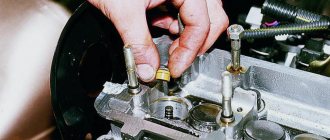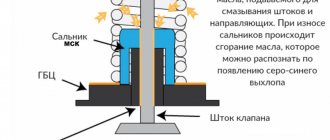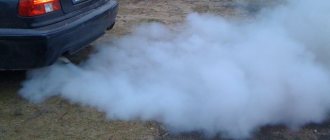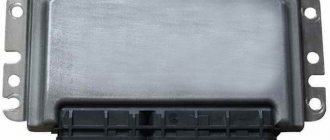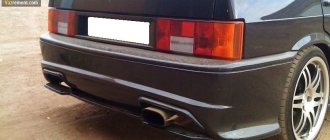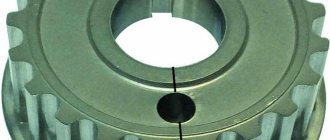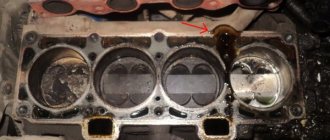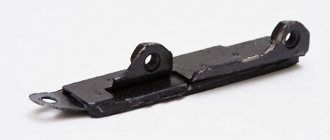The replacement procedure should not be delayed, since an increase in engine oil consumption incurs additional financial costs and environmental problems.
Owners need to know which valve stem seals are better for the reason that they can navigate the offers of service centers or retail outlets and make the right choice. Today there is no total shortage of not only valve seals, but also spare parts in general. All that remains is to learn correctly, choose good quality products and distinguish fakes from originals.
Why did it happen so?
Perhaps the automatic requests do not belong to you, but to another user accessing the network from the same IP address as you. You need to enter the characters into the form once, after which we will remember you and be able to distinguish you from other users exiting from this IP. In this case, the page with the captcha will not bother you for quite a long time.
You may have add-ons installed in your browser that can make automatic search requests. In this case, we recommend that you disable them.
It is also possible that your computer is infected with a virus program that is using it to collect information. Maybe you should check your system for viruses.
If you have any problems or would like our support team, please use the feedback form.
Replacing the crankshaft oil seal on a VAZ 2110 8 valves
In this section we will talk about dismantling the front crankshaft cuff. To carry out this work, you will need a standard set of keys, screwdrivers and, of course, new cuffs. Drive the car onto a lift, pit or overpass, and then start working according to the algorithm:
Remember that you should not save on these parts - their cost is not high, but replacement work is quite a lot. Plus, a poor quality product can end up causing serious engine damage, which will drain your wallet and waste a lot of your time.
Which valve stem seals are better? Purpose of valve stem seals
The pressing question of which valve stem seals are better can be found on absolutely any auto forum.
Drivers are actively discussing this topic, because there is no specific guide for choosing valve stem seals on the Internet. More precisely, it was not until recently. Here is a clear and detailed scheme for selecting high-quality caps. Enjoy it and don't forget to tell your friends. Which valve stem seals are better when there are so many offers at service centers and parts sales points? Sooner or later, everyone who drives a used car will have to face the issue of replacing valve stem seals. It is better not to delay the replacement procedure. Otherwise, oil consumption will increase significantly, and environmental problems will arise with it. It is pleasantly pleasing to know that at least there is no shortage in our country. There is only one thing left - to learn how to choose products of excellent quality.
To minimize friction of engine elements, lubricant is used. The whole point of salt is that its amount should not be too small or too large. The key task of the caps is precisely to minimize the entry of lubricant into the combustion chamber. The pairing of such a pair as a valve stem and a guide sleeve is simply impossible to imagine without valve seals. They serve to seal the structure and are made of reinforced, oil-resistant rubber. An additional spring presses the upper part of the seals against the valve stem.
Relatively recently, fluoroplastic was used in the production of valve seals. However, today it is used extremely rarely. Take the instructions for any car. When it comes to replacing parts, the recommendations are the same everywhere - install the components supplied by the manufacturer. Drivers often neglect this advice. This is due to the fact that new materials and more modern technologies appear regularly. Therefore, when the time comes to change the valve stem seals, “some kind of fluoroplastic” becomes irrelevant.
There are more than enough reasons to remove the old caps and install new ones. One of the key ones is that the edge of the seals has worn out, which results in insufficient crimping of the valve stem. When the engine is constantly running, the components perform a colossal amount of work. The temperature rises to prohibitive levels. The impact of such an aggressive environment has a significant impact on resistance and durability. Over time, the rubber that underlies most parts becomes hard. Cracks, abrasions and heavy wear are common.
Everything changed when the domestic auto industry adopted new technologies from Porsche. The production of caps has experienced a rebirth. Now each product was based on fluorine rubber. The use of innovative material at that time gave phenomenal results. Especially when comparisons were made with Elring and Goetze products.
When the valve guide and valve stem are not worn out, Reinz caps show decent results. They are made of high quality rubber and are even suitable for Mercedes M110 and M123 engines. Let us recall that previously the components for them were made of fluoroplastic, which we discussed above. Products from Glazer, Payen and other companies enjoy a good reputation in the market.
There are several reasons for replacing “native” caps with imported ones. Often recommended products cost 5-7 dollars or more per piece. It also happens that during the assembly process one of the valve stem seals is damaged. Knowing the characteristics of spare parts will help you select replacements. We tried to tell you in accessible words which valve stem seals are better. We can discuss the pros and cons of products for a long time. But the fact remains that the quality of domestic valve stem seals is still inferior to foreign products.
Tips for selecting and using additives for valve stem seals
When a car is used for a long time, many drivers notice a sharp increase in the amount of oil consumed. At the same time, smoke with a bluish tint comes out of the exhaust pipe. Such signs indicate that it is necessary to diagnose the power plant in the near future. This is often due to poor or malfunctioning valve stem seals (VSC). Don't rush to send your car for repairs and spend a lot of money. The situation can be solved by special additives that are designed to restore these caps. It is important to consider that the use of additives for valve stem seals is not always considered correct and rational. But there are situations when additives can really help correct the current situation and prevent costly repair work in the future.
Functions of the caps
Caps, as an integral part of a car engine, are designed to prevent excess oil from penetrating into the gap formed by valve guides and valve stems. For valve stem seals, a special type of rubber is used in their manufacture. Gradually, as the vehicle is used, this material may deform and collapse. But basically there is a violation of its elasticity. Due to the loss of their original properties, the caps do not cope with their functions, oil enters in greater quantities than required. This increases oil consumption. If we talk about blue smoke, then this is a sign of combustion processes occurring in the engine.
To solve the problem of a malfunction of the valve stem seals, you can go in two ways:
- Replace the caps with new ones. Despite the apparent simplicity of these components, replacing MSCs is quite difficult. A car service will require a lot of money, and not everyone has enough experience, skills, tools or even free time to replace it themselves.
- Use special additives. This is a good way to restore the elasticity of the caps. The special composition of the additive allows rubber products to return to their previous characteristics, thereby allowing them to effectively perform their functions.
If you decide to focus on additives, then be sure to consider in more detail the issue of their use and the relevance of use for problems with valve stem seals.
When will they help
Agree that there are a lot of rumors and controversies surrounding automobile additives; opinions differ, and sometimes they are completely opposite. Therefore, you need to understand how MSC supplements help, and whether they are worth using at all. Objectively, such automotive chemistry has its positive and negative sides. But the result of the application directly depends on the literacy of the car owner himself, his attentiveness and compliance with all the instructions of the manufacturer of those same additives.
If you are one of the motorists who does not skimp on branded lubricants and buys only the most suitable oils for your vehicle, this is absolutely the right approach. The thing is that such oils are already supplied from the factory with the addition of all the necessary additives.
By adding additional additives to them, you change the properties, characteristics and capabilities of lubricants. This does not always benefit the car. Ideally, oil manufacturers should indicate in the composition exactly what additives and in what quantity they added to the motor or transmission fluid. But so far there are no such requirements.
If you do not want to be disappointed in the effectiveness of oil seal additives, then carefully read the following information.
In real conditions, the use of additives is justified only in situations where the rubber seals, which are the caps, have minor defects or damage. That is, when not drops of oil pass through them, but entire streams, you should not expect a miracle from the additive. She won't help. Therefore, you cannot count on the omnipotence of auto chemicals.
The principle of operation of additives for valve stem seals is that auto chemicals soften rubber products, they swell, restore their geometry and do not allow excess amounts of lubricant to penetrate through them. If the cap is cracked or partially collapsed, then you do not need an additive. You will only be wasting money, for which it is better to contact a good car service for a complete replacement of the MSC. And the real benefit is achieved by pouring the additive into the oil when the caps have just begun to gradually wear out, but have not led to serious changes in engine operation. They are used for minor deformities or as a means of prevention.
Features of additives
First, remember that there are no special separate additives for softening exclusively valve stem seals. These are universal additives that are used for problems with:
- caps;
- oil seals;
- gaskets;
- other rubber seals.
Additives are used to extend the service life of products, soften their structure and restore the original functionality of sealing various engine elements. High-quality compositions are able to restore the elasticity of even those elements that have become very rough, hardened and worn out, but not destroyed. Additionally, MSC additives allow you to gently clean the channels and lubrication system of the car. This has a positive effect on the operation of the power plant. Carbon deposits are eliminated, slag formations are removed, and various products of oxidative processes are removed.
That is, one such additive has a complex effect. There is no need to pour in a whole scattering of all kinds of additives to affect each individual unit or mechanism. This saves money and does not greatly change the composition of the engine fluid in the car.
Selection of softening additives
The selection of suitable additives aimed at restoring valve stem seals is somewhat complicated by the wide range of similar products on the market. Manufacturers offer a whole range of additives, each of which is aimed at performing specific tasks. Among them, compositions designed to restore the elasticity of valve stem seals and other rubberized sealing elements are deservedly popular.
To help you navigate the proposals a little, we will introduce you to some of the most popular, effective additives that have earned recognition among car owners. Not surprisingly, they all represent famous brands. A low-quality additive does not stay around for long, but quickly disappears from the shelf as soon as negative reviews about it appear. This is a calculation for quick profit. Famous companies that value their own reputation are not interested in reducing interest in their products. Therefore, they are trying to apply new technologies and use current developments in the field of automotive chemistry. As a result, we get, although more expensive, high-quality and truly useful supplements.
- Liqui Moly;
- Xado;
- Wagner;
- Hi-Gear.
These are popular brands that offer their solutions to the problem with valve stem seals. Therefore, we will consider them separately.
Wagner
The product that is needed in this case is called Oil Stop. A time-tested, quality product that performs well in restoring various seals in a car. An important advantage of the drug is the lack of exposure to chemicals that are part of motor oil. The product immediately gets onto the gaskets, caps and seals, expanding their original volume. This drug is widely used in eliminating leaks of lubricating fluids and in hydraulic systems.
Hi-Gear
A wide-range manufacturer that produces all kinds of automotive chemicals, including additives for restoring the elasticity of rubber gaskets. In our case, you should pay attention to two options for auto chemical products:
- HG 2246;
- HG 2243.
These are two modern high-tech additives that prevent oil oxidation, restore the original properties of engine oil, and increase compression. Practice and testing by car enthusiasts have clearly shown that the substances behave very well when interacting with rubber elements. The ability to restore rings and caps even if they are moderately deformed is noted. None of the competitors have been able to achieve this, which makes Hi-Gear one of the first choices for car owners.
To get the maximum benefit from the drugs, the manufacturer advises pouring them into cars with average or high mileage. On relatively new cars, using the additive will not give a noticeable effect, although for preventive purposes it will not hurt.
Ukrainian manufacturer of auto chemicals, which has managed to gain worldwide popularity. From a small enterprise in Kharkov, Xado has turned into a brand recognizable far beyond Ukraine, with high quality and reasonable prices. If the oil scraper rings suffer from carbon deposits that have formed on them, Hado will be almost the best solution in the current situation. It is important to carefully read the manufacturer's instructions. Do not fill the mixture more than normal or ahead of time. If you overdo it, or uncontrollably pour auto chemicals into your car, even with good intentions, it will not lead to anything good.
Liqui Moly
Another world-famous brand that has not only a well-developed advertising department, but also high-tech equipment. Entire laboratories and a huge staff of specialists are working to create new products that will meet all international standards, requirements and meet the needs of car owners themselves.
The main player in eliminating problems with valve stem seals is an additive called Oil Verlust Stop from the manufacturer Liqui Moly. Now this additive is widespread throughout the world, which makes it easy to purchase a bottle of Liqui additive in almost any automotive chemical store. This drug is a universal remedy for solving the problem of engine oil leaks. With its help you can cope with minor ailments of oil seals, rubber gaskets and valve stem seals.
The most significant positive effect of Liqui Moly is the protection of valve stem seals and rings from waste products of lubricants. This allows the material to return to its former elasticity and functionality. All of the above additives are actively used by car enthusiasts and specialists when repairing various vehicles. This once again proves their high degree of effectiveness.
Just don’t place high hopes on additives. This is not a panacea, but simply a preventive and partially repair remedy. With their help, you can solve the problem for a while and delay mandatory repairs. In case of severe damage, when the valve stem seals can no longer perform their functions at all, not a single additive will help solve the problem without interfering with the design itself. Therefore, it is better to carry out preventive measures, use high-quality oils and add appropriate additives as necessary.
Which valve stem seals are best? Quality above all
The time has come to replace them and the owners are faced with the question of which valve stem seals are better.
Whether the owners want it or not, one day they will have to think about it, especially if the car already has a “solid” mileage. On some models, this need may arise after a long period of operation, while on others it happens more often. The replacement procedure should not be delayed, since an increase in engine oil consumption incurs additional financial costs and environmental problems.
Owners need to know which valve stem seals are better for the reason that they can navigate the offers of service centers or retail outlets and make the right choice. Today there is no total shortage of not only valve seals, but also spare parts in general. All that remains is to learn correctly, choose good quality products and distinguish fakes from originals.
What is the crankshaft oil seal for and where is it located?
The main purpose of the oil seal is to prevent engine oil from leaking from the engine. Reliable sealing of the holes is possible due to the pressure inside the crankcase, which ensures the tightest possible pressure of the oil seal to the part. Thanks to this principle of operation, the liquid in the internal combustion engine system does not leak and does not subject the engine components and assemblies to excessive frictional loads.
The oil seal is made of heat-resistant material: fluorine rubber, silicone. Also on the outside of the seal you can see some notes; most often, they tell the driver in which direction the crankshaft is rotating. Information is necessary in order to correctly install new sealing elements
The design of the power plant determines the presence of two oil seals - front and rear. The rear rubber product is designed for installation on the part of the crankshaft that connects to the flywheel. The crankshaft end is a flange, so the rear seal has impressive dimensions and a fairly large amount of material, which ensures its long service life.
The front rubber element is mounted on the limit switch, which is the drive for the engine mechanisms. Its dimensions are smaller than the similar part at the other end, therefore the front oil seal is significantly inferior in terms of service life.
Why are they installed in engines?
All rubbing couples in engines receive a certain portion of lubricant to reduce friction, and the task of oil seals is to reduce its entry into the combustion chamber to a minimum. Such a pair in the cylinder head is the guide sleeve and the valve stem. It is impossible to make this connection without a gap, so valve seals are used for sealing. They are made from special oil-resistant reinforced rubber. The upper part of these seals is pressed against the valve stem by a spring.
There was a time when PTFE was widely used for these, but nowadays it is rarely used in the production of these replacement parts. Instructions for car repair and operation recommend that when replacing, install only those parts that were installed by the manufacturer. Today, this recommendation is often violated, since the use of high-quality materials and modern technologies makes it possible to create products that are in no way inferior, and sometimes even superior in their characteristics, to the original caps.
Tips for selecting and using additives for valve stem seals
Functions of the caps
Caps, as an integral part of a car engine, are designed to prevent excess oil from penetrating into the gap formed by valve guides and valve stems. For valve stem seals, a special type of rubber is used in their manufacture. Gradually, as the vehicle is used, this material may deform and collapse. But basically there is a violation of its elasticity. Due to the loss of their original properties, the caps do not cope with their functions, oil enters in greater quantities than required. This increases oil consumption. If we talk about blue smoke, then this is a sign of combustion processes occurring in the engine.
To solve the problem of a malfunction of the valve stem seals, you can go in two ways:
- Replace the caps with new ones. Despite the apparent simplicity of these components, replacing MSCs is quite difficult. A car service will require a lot of money, and not everyone has enough experience, skills, tools or even free time to replace it themselves.
- Use special additives. This is a good way to restore the elasticity of the caps. The special composition of the additive allows rubber products to return to their previous characteristics, thereby allowing them to effectively perform their functions.
If you decide to focus on additives, then be sure to consider in more detail the issue of their use and the relevance of use for problems with valve stem seals.
When will they help
Agree that there are a lot of rumors and controversies surrounding automobile additives; opinions differ, and sometimes they are completely opposite. Therefore, you need to understand how MSC supplements help, and whether they are worth using at all. Objectively, such automotive chemistry has its positive and negative sides. But the result of the application directly depends on the literacy of the car owner himself, his attentiveness and compliance with all the instructions of the manufacturer of those same additives.
If you are one of the motorists who does not skimp on branded lubricants and buys only the most suitable oils for your vehicle, this is absolutely the right approach. The thing is that such oils are already supplied from the factory with the addition of all the necessary additives.
By adding additional additives to them, you change the properties, characteristics and capabilities of lubricants. This does not always benefit the car. Ideally, oil manufacturers should indicate in the composition exactly what additives and in what quantity they added to the motor or transmission fluid. But so far there are no such requirements.
If you do not want to be disappointed in the effectiveness of oil seal additives, then carefully read the following information.
In real conditions, the use of additives is justified only in situations where the rubber seals, which are the caps, have minor defects or damage. That is, when not drops of oil pass through them, but entire streams, you should not expect a miracle from the additive. She won't help. Therefore, you cannot count on the omnipotence of auto chemicals.
The principle of operation of additives for valve stem seals is that auto chemicals soften rubber products, they swell, restore their geometry and do not allow excess amounts of lubricant to penetrate through them. If the cap is cracked or partially collapsed, then you do not need an additive. You will only be wasting money, for which it is better to contact a good car service for a complete replacement of the MSC. And the real benefit is achieved by pouring the additive into the oil when the caps have just begun to gradually wear out, but have not led to serious changes in engine operation. They are used for minor deformities or as a means of prevention.
Features of additives
First, remember that there are no special separate additives for softening exclusively valve stem seals. These are universal additives that are used for problems with:
- caps,
- oil seals,
- gaskets,
- other rubber seals.
Additives are used to extend the service life of products, soften their structure and restore the original functionality of sealing various engine elements. High-quality compositions are able to restore the elasticity of even those elements that have become very rough, hardened and worn out, but not destroyed. Additionally, MSC additives allow you to gently clean the channels and lubrication system of the car. This has a positive effect on the operation of the power plant. Carbon deposits are eliminated, slag formations are removed, and various products of oxidative processes are removed.
That is, one such additive has a complex effect. There is no need to pour in a whole scattering of all kinds of additives to affect each individual unit or mechanism. This saves money and does not greatly change the composition of the engine fluid in the car.
Selection of softening additives
The selection of suitable additives aimed at restoring valve stem seals is somewhat complicated by the wide range of similar products on the market. Manufacturers offer a whole range of additives, each of which is aimed at performing specific tasks. Among them, compositions designed to restore the elasticity of valve stem seals and other rubberized sealing elements are deservedly popular.
To help you navigate the proposals a little, we will introduce you to some of the most popular, effective additives that have earned recognition among car owners. Not surprisingly, they all represent famous brands. A low-quality additive does not stay around for long, but quickly disappears from the shelf as soon as negative reviews about it appear. This is a calculation for quick profit. Famous companies that value their own reputation are not interested in reducing interest in their products. Therefore, they are trying to apply new technologies and use current developments in the field of automotive chemistry. As a result, we get, although more expensive, high-quality and truly useful supplements.
- Liqui Moly,
- Xado,
- Wagner,
- Hi-Gear.
These are popular brands that offer their solutions to the problem with valve stem seals. Therefore, we will consider them separately.
Wagner
The product that is needed in this case is called Oil Stop. A time-tested, quality product that performs well in restoring various seals in a car. An important advantage of the drug is the lack of exposure to chemicals that are part of motor oil. The product immediately gets onto the gaskets, caps and seals, expanding their original volume. This drug is widely used in eliminating leaks of lubricating fluids and in hydraulic systems.
Hi-Gear
A wide-range manufacturer that produces all kinds of automotive chemicals, including additives for restoring the elasticity of rubber gaskets. In our case, you should pay attention to two options for auto chemical products:
- HG 2246,
- HG 2243.
These are two modern high-tech additives that prevent oil oxidation, restore the original properties of engine oil, and increase compression. Practice and testing by car enthusiasts have clearly shown that the substances behave very well when interacting with rubber elements. The ability to restore rings and caps even if they are moderately deformed is noted. None of the competitors have been able to achieve this, which makes Hi-Gear one of the first choices for car owners.
To get the maximum benefit from the drugs, the manufacturer advises pouring them into cars with average or high mileage. On relatively new cars, using the additive will not give a noticeable effect, although for preventive purposes it will not hurt.
Ukrainian manufacturer of auto chemicals, which has managed to gain worldwide popularity. From a small enterprise in Kharkov, Xado has turned into a brand recognizable far beyond Ukraine, with high quality and reasonable prices. If the oil scraper rings suffer from carbon deposits that have formed on them, Hado will be almost the best solution in the current situation. It is important to carefully read the manufacturer's instructions. Do not fill the mixture more than normal or ahead of time. If you overdo it, or uncontrollably pour auto chemicals into your car, even with good intentions, it will not lead to anything good.
Liqui Moly
Another world-famous brand that has not only a well-developed advertising department, but also high-tech equipment. Entire laboratories and a huge staff of specialists are working to create new products that will meet all international standards, requirements and meet the needs of car owners themselves.
The main player in eliminating problems with valve stem seals is an additive called Oil Verlust Stop from the manufacturer Liqui Moly. Now this additive is widespread throughout the world, which makes it easy to purchase a bottle of Liqui additive in almost any automotive chemical store. This drug is a universal remedy for solving the problem of engine oil leaks. With its help you can cope with minor ailments of oil seals, rubber gaskets and valve stem seals.
The most significant positive effect of Liqui Moly is the protection of valve stem seals and rings from waste products of lubricants. This allows the material to return to its former elasticity and functionality. All of the above additives are actively used by car enthusiasts and specialists when repairing various vehicles. This once again proves their high degree of effectiveness.
Just don’t place high hopes on additives. This is not a panacea, but simply a preventive and partially repair remedy. With their help, you can solve the problem for a while and delay mandatory repairs. In case of severe damage, when the valve stem seals can no longer perform their functions at all, not a single additive will help solve the problem without interfering with the design itself. Therefore, it is better to carry out preventive measures, use high-quality oils and add appropriate additives as necessary.
Why do they need to be replaced?
The only reason for removing them and installing new parts can be wear of the edge of the valve seals, which is used to compress the valve stem. During engine operation, they perform a huge amount of work, experience high temperature loads and exposure to an aggressive environment. This cannot but affect their resistance and durability. Most of these spare parts are based on rubber, which, under the influence of all these negative factors, begins to harden, the working edges begin to crack, wear out and wear out.
This leads to a gap for engine oil to penetrate into the working chamber, resulting in “dirty” exhaust and increased lubricant consumption. You should not be afraid that replacement will be very frequent; manufacturers have learned to produce good products whose service life is 100,000 km, or even more. But unfortunately, there are still many such machines for which replacement happens more often than usual.
Necessary tool
In order to change the seals, you need to prepare the following set of tools:
Front crankshaft oil seal.
Rear crankshaft oil seal.
Articles
As for new oil seals, it is better to change the front and rear at once. They are also called big and small.
A set of branded ESPRA oil seals.
Replacement algorithm
In order to replace a part, you need to perform the following sequence of actions:
Unscrew the two bolts on the sides of the cover.
How to choose the best?
Almost until the mid-90s, domestic cars were equipped with products from the Kursk Rubber Products Plant. The average temperature in the working area is approximately 1800°C, and the rubber used to make them was only rated up to 1500°C. Therefore, the mileage of such parts was no more than 30 thousand km. mileage Today they are not produced, but occasionally they still appear on sale.
With the arrival of technologies from Porsche in the domestic auto industry, the production of caps based on a new composition began to develop. It was based on fluorine rubber, the use of which gave positive results. After comparative tests with products from such and Elring
"Good results were obtained.
For an unworn pair of valve stem and guide sleeve, caps perform well. They are based on high-quality rubber; they successfully replace Mercedes M110 and M123
fluoroplastic products.
In addition to the names listed, products from Glazer
and other companies have proven themselves well.
Replacing the crankshaft oil seal on a VAZ 2110 16 valves
In order to remove and replace the front crankshaft oil seal of a VAZ 2110 (16 cl), you will need the same standard set of tools. All actions are also similar to the procedure for replacing the cuff on an 8-valve engine. So, the algorithm for removing the front cuff from the crankshaft is as follows:
If you are replacing the front cuff, it makes sense to replace the back one as well. And if you do this at the same time, you will save time, since the components are replaced from one place with the removal of the wheel and, possibly, the fender liner.
Source
Sparco24 › Blog › Installing 16V camshafts
In this article we will look at the installation of sports and tuning camshafts on VAZ 2112, 21124, 21126 and 11194 engines. First, you need to remember that engines 2112 and 21124 have their own timing belt drive and are incompatible with the timing belt of engines 21126 and 11194 - this worth considering when purchasing split gears. Engine gears 21126 and 11194 have rounded teeth, so the belt, pump, lower crankshaft gear and camshaft gears have their own. To install the camshafts you need to do the following:
1. Disconnect the TPS, IAC and mass air flow sensor connectors, loosen the clamps holding the inlet pipe on the receiver, loosen the ventilation clamp for the crankcases of the cylinder head cover and dismantle the intake pipe assembly with the mass air flow sensor;
2. Unscrew the nuts that secure the receiver to the cylinder head; it is most convenient to do this with a ratchet with a 13-mm socket;
3. Remove the receiver assembly with the throttle;
4. Remove the timing belt cover using a ratchet and a short 8mm socket;
5. Loosen the bolts of the camshaft gears;
6. Set the crankshaft position to TDC of cylinder 4, aligning the mark on the flywheel and, loosening the tension roller, remove the belt from the camshaft gears;
It will be useful How to choose and change the oil in a nissan qashqai variator: reviews and tips
7. Completely unscrew the bolts of the camshaft gears and remove the gears themselves. Be careful - the keys for fixing the gears on the camshafts can fly out and, due to their small size, can easily get lost;
8. Using a ratchet and a 8mm socket, unscrew the timing cover bolts and remove it. Using the same tool, unscrew the bolts of the bed and also dismantle it;
9. Remove the standard camshafts, not forgetting to remove the keys that secure the gears;
10. Remove the hydraulic compensators using a magnet. It is advisable to number the hydraulic compensators by wells in order to install them in their places. If the camshafts are not full-base, install the included bearings on the valve stem;
Camshafts 2112 lift 11.8/11.8 mm Sport
7,800 rub. Club price 7,500 rub. 11. Place new camshafts and check them for rotation in bed. If the cams cling to the hydraulic compensator wells slightly, use a sharpened screwdriver or chisel to carefully modify the edges of the wells to rotate the camshaft cams. To ensure that this procedure is as safe as possible and that shavings do not fall into the wells, it is recommended that before processing the well, fill it with cotton wool or a piece of cloth; after processing, this should be removed and the well should be blown out. If the camshaft cams do not turn at all, and the wells need to be thoroughly modified, it is strongly recommended to dismantle the cylinder head, modify the wells using a drill or machine, wash it and install it back, otherwise, in the case of rough return, excess chips can clog the oil channel or, by over-modifying the well, worsen the performance of the hydraulic compensator by reducing oil pressure;
12. Clean the surface of the bed from sealant on both sides; the seats of the bed bolts must be blotted from oil using a thin screwdriver and a piece of cloth so that when tightening the bolt you do not pull out the thread (remember that oil does not compress, and if the bolt has nowhere to twist - it will begin to pull the threads out of the cylinder head), apply new sealant to the lower plane of the bed;
13. Having aligned the new camshafts with the veneer grooves vertically upward, place the bed and tighten its bolts, starting from the central holes towards the timing belt and pump;
14. Place the split gears on the camshafts and tighten their bolts, put on the timing belt; Guided by this article, set the valve timing recommended by the manufacturer; Clean the cylinder head cover, apply new sealant and close the cylinder head cover, tighten it with bolts, starting from the center and moving away to the sides of the timing belt and pump; Repeat the installation operations of the receiver, timing case and sensor connectors in reverse order.
Attention! To achieve the maximum effect from installing camshafts, it is mandatory to change the ECU program online
How to change pistons to plug-in or Avtramat pistons with your own hands?
Thus, we approached the issue of replacing pistons on a VAZ Priora car with our own hands.
Prepare a set of wrenches in advance:
In the event that the replacement of elements is carried out on a car with high mileage, using an internal meter you will have to measure the distances from the upper edge of the cylinder in the transverse and longitudinal direction of the engine. In this case, you need to deviate from the top edge by 3, 10, 60 and 112 mm, respectively, you should end up with four values. This way you can determine how worn the cylinders are. If the wear is small and amounts to 0.05 mm, then this distance can be compensated for by installing elements with a slightly larger diameter. However, if the wear is 0.15 mm or more, then your cylinders will need boring. To do this, we recommend combining this process with the installation of plug-in elements. Immediately before disassembly, the motor should be cleaned. Use wrenches to unscrew the screws that secure the right engine support, as well as the front support and generator bracket. All brackets are dismantled. Then you should disconnect the pipeline, the block head, the flywheel, and the filter element. The pump supply pipe to the cylinder head is also disconnected. Now you will need a workbench or a suitable stand. Next, the oil pan, oil pump and oil receiver are dismantled. The screws securing the rear crankshaft oil seal are also unscrewed using a wrench. The holder itself can be dismantled by prying it with a screwdriver into the grooves on the body. Then you should unscrew all the bolts of the connecting rod caps one by one, and the connecting rods themselves with the pistons should be dismantled. After this, the piston rings are removed. The ring itself is removed from its installation location using the same screwdriver
Here, pay attention to the condition of the rings - if they are worn out, then it is better to change them. Using a mandrel, the piston pin is pushed out, after which the piston itself can be removed. After replacement, all assembly steps are carried out in the reverse order. Make sure that the mark on the bottom of the element is directed in the same direction as the arrows on the connecting rod are pointing.
Make sure that the mark on the bottom of the element is directed in the same direction as the arrows on the connecting rod are pointing.

